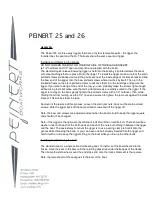
scheduled
maintenance
Before Each Use
Review the
Safety Checks and Services
section of this Owner’s
Manual. There are important functions that must be followed
before, during and after every outing, without fail! The
Safety
Checks and Services
notes that all drain plugs must be reinstalled
prior to operating the boat!
Check Raw Water Intake Strainer
(where equipped)
Because a clogged raw water intake strainer puts undue strain on
the engine(s), the intake should be checked prior to starting the
boat. Boats with closed cooling systems are not equipped with this.
Step 1:
The raw water intake strainer serves to reduce or prevent
the intake of debris into the engine’s cooling system.
Therefore, it is critical that it be checked prior to start-
ing the engine. If operating in brackish or dirty water
with considerable flora or algae, it is advisable to shut
off the engine during an extended outing to be sure that
the strainer is not clogged. If there is debris, even if it
is biodegradable, it should be manually removed from
the strainer. If there has been evidence of material in
the strainer routinely at the body of water on which the
boat is operated, it is recommended that the strainer be
cleaned again at the conclusion of each outing as it may
be easier to remove material when it is still wet.
Inspect the Battery Connections
and Hold-Downs
Because poor connections or hold-downs may result in erroneous
voltmeter readings, MasterCraft recommends doing this before
starting the boat.
Step 1:
Ensure the engine is OFF and the engine safety starting
switch disconnected.
Be certain that the throttle/shift
control lever is in neutral.
Locate the battery. Batteries
are placed in a variety of locations, depending on the
model. Check under the observer seat or behind the
rear seat.
Step 2:
Check that the battery post connections are clean and
tight. If not:
• Loosen and remove the negative terminal connection first. Be
careful not to touch the positive terminal with the wrench.
• Loosen and remove the positive terminal connection.
• Remove the battery hold-downs and remove the battery from
the boat.
• Clean corrosion from the battery posts with a battery termi-
nal cleaner.
• Clean the battery with a water-and-baking-soda solution. Use
care to avoid allowing the solution to enter the battery vents.
Rinse the battery with fresh water.
Battery electrolyte fluid is dangerous. It contains sulfuric acid,
which is poisonous, corrosive and caustic. If electrolyte fluid is
spilled or placed on any part of the human body, immediately
flush the area with large amounts of clean water and immediately
seek medical attention.
• Use a battery terminal cleaning brush to remove corrosion
from the inside of the battery terminals. Clean the terminals
with a water-and-baking-soda solution and rinse with fresh
water.
• Check the battery box that normally holds the battery in
place to determine whether there is evidence of battery fluid
inside it. Battery fluids are corrosive and can cause perma-
nent damage to the battery box. If fluid is evident, wash out
MasterCraft 2009 Owner’s Manual - Page 16-1
















































